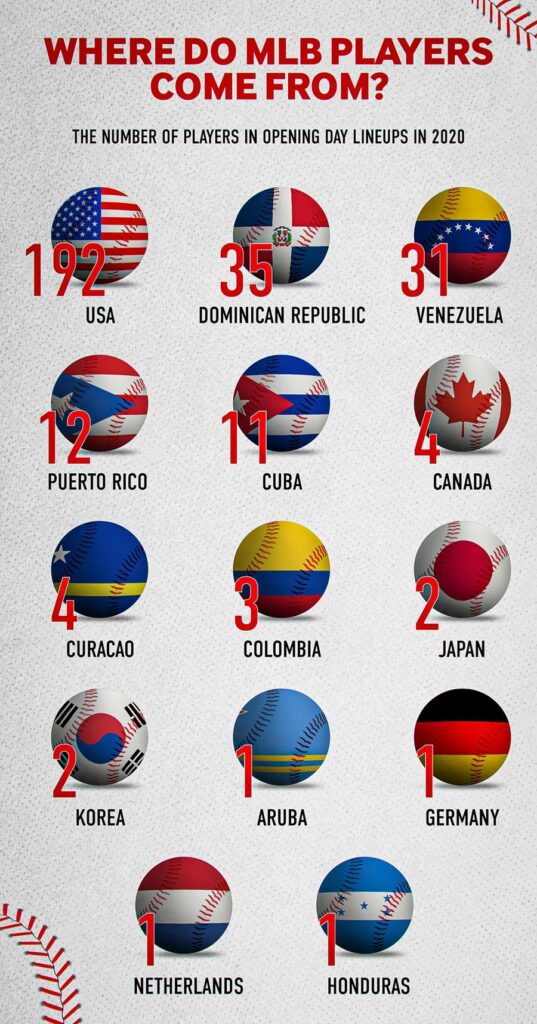The once-popular game of the country, baseball had its own glorious past. From so many movies and media icons, print, ads, and TV shows, the game became the poster for the US. If anything said a US occupation in a country, it was baseball. The cultural icons were a trademark and generations grew up with it. But, the present generation and the forthcoming ones may be more interested in basketball or football. Baseball is and will be the one in history.
Major League Baseball and Latin America
If you see the lineup for MLB 2020, you will find something of value. But, it is only when you compare it with the previous records that you understand what the point is. The chart from Betway below only further illustrates the stats.
- The USA was the top-ranking nation to send 192 players in the lineup.
- This was soon followed by the Dominican Republic but with weigh less around 35 only.
- The 3rd ranked nation was Venezuela with 31 players.
- Then, Puerto Rico came with 12 of their native players.
- Finally, Cuba supported 11 players.

The rest of the nations include Canada, Colombia, Korea, Japan, Aruba, and Germany. This tells us a few things. It tells us that the US had over 70% players in the MLB and, the best of the world around 30%. Roughly, 1/3 of the entire composition but, if we tell you that prior to the 1950s, Major League Baseball didn’t even allow other countries and race players to participate in an American sport? Latin American countries were not allowed to play in this sport event. Well, that was half a century ago and today, in 2020 the lineup says a totally different story.
Now, let us compare this with previous records.
International Involvement of MLB in Decades
Starting in the 1950s, the first-ever player was allowed in the team; in 1960 the first milestone was achieved. It was then that a significant number, 8.33% of the entire lineup was overseas talent. It jumped to over 10% in the next 20 years and to over 25% in the next 20 years. That is, by 2000 the composition was 25.35% overseas talent and the rest of the US.
And, as we had mentioned in the historical context when the National League and American League had merged in 1903, baseball was the only shining star in the US. And for the next 50 years or so, Latin America has barred entry whatsoever. But, falling interests and popularity in the country allowed more opportunities for nearby countries. From Central America, the Caribbean, Latin America, young and talented players came to the US and participated in the games. And, with success, they even became fan favorites and loved by Americans.
The significant achievements in the international and diversity pool can be listed as follows.
- It wasn’t until 1960 that the situation changed and diversity and inclusion came along. There were 12 players from overseas but the Americans looked at them with distrust.
- Luis Aparicio came in 1956 as the first overseas rookie. And, Zoilio Versalles came in 1965 as his first overseas MVP.
- But, then the clock started ticking faster and just 3 years later in 1969, the first young runner Mike Cuellar came. In 1971, the start of baseball Roberto Clemente was brought and his fans still remember the days.
- In 1973, Roberto Clemente became the first overseas player to be inducted into the National Hall of Fame, a well-deserving status. And, then in 2012, the first overseas top draft selection was given to Carlos Correa.
Thus, with the above statements, MLB grew more diverse, rich with talented players from all over the world, and inclusive. This was taken with a surprise first, smile next, and is slowly becoming a norm.
Conclusion
Today, polls show that 9% of Americans rank baseball as their favorite sport. So it is not a surprise that the decreasing popularity is a cause why the next generation of Americans will favor football or basketball more than baseball. Given that scenario, countries like Venezuela, Dominican Republic, and Puerto Rico rank Baseball as their No. 1 sport. From the present trend, the future of MLB looks successful but with a more international presence. Though the tally stands at 1/3 at the present, it is expected to grow in the next 20 years or so steadily.

